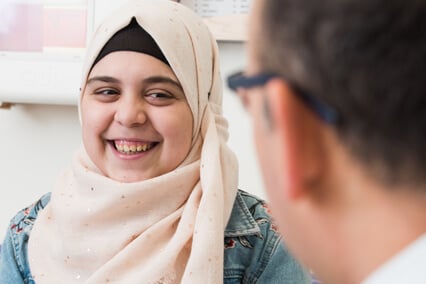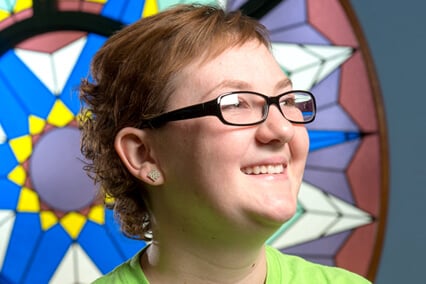Triosephosphate Isomerase Deficiency: Wyatt's Story
Children’s Mercy Oncologist treats rare blood disorder with Novel BMT approach
Four-year-old Wyatt Haney has been fighting for his life since the day he was born at a Joplin, Mo., hospital.
“Within a few hours of Wyatt’s birth, he literally turned a ‘Shrek-like shade of green,’” described his mother, Amanda Haney.
Initially, Wyatt tested positive for hemolytic anemia, a blood disorder that causes the premature destruction of red blood cells, and can cause the “greenish” look. Fortunately, with treatment guidance from the experts at Children’s Mercy, Wyatt’s skin color changed to a more natural flesh tone.
Though he now looked healthy, Wyatt was still gravely ill. At only 2 weeks old, he had his first appointment with a pediatric hematologist/oncologist at Children’s Mercy Kansas City.
From the beginning, the doctor knew Wyatt had a blood disorder, but pinpointing the specific condition was a process of elimination, starting with the most common problems.
“We traveled from our home in Galena, Kan., to Children’s Mercy every two weeks,” Amanda said. Each time the family hoped for an answer.
An answer for Wyatt
Finally, 11 months after he was born, Wyatt’s family and his medical team had an answer—TPI, or triosephosphate isomerase deficiency. TPI is an extremely rare genetic multisystem disorder first identified in 1964. Since that time, only 100 patients have been diagnosed worldwide, and only four are living today. Wyatt is one of those four.
Patients with TPI lack the enzyme necessary to break down certain sugars in the body. In addition to hemolytic anemia, they also experience severe, progressive neurologic and cardiac symptoms.
The disorder is inherited. Both Amanda and her husband, Bobby, are carriers, but their other two children are unaffected.
With the TPI diagnosis in hand, Wyatt and his family were referred to Gary D. Myers, MD, a pediatric hematologist/oncologist with expertise in bone marrow transplant at Children’s Mercy.
Wyatt’s best chance for survival
“The first symptom of TPI is hemolytic anemia,” Dr. Myers explained. “Bone marrow transplant can cure certain forms of hemolytic anemia due to enzyme deficiencies by replacing red blood cell production with a donor’s marrow. However, the risks of transplant often outweigh the potential benefit and the risks of other supportive care.”
Wyatt’s case was different though. Unlike other forms of hemolytic anemia, the TPI would likely progress to neurodegenerative disease and heart failure, eventually leading to death.
“There was some basic research in fruit flies showing if you could replace this missing enzyme, you might also reverse the neurodegenerative effects of the TPI,” Dr. Myers said. “But this is such a rare condition, we couldn’t guarantee a transplant would work. There is also no published record of bone marrow transplant for TPI deficiency. This was new territory.”
After carefully weighing the pros and cons of transplant with the BMT team, Amanda and Bobby agreed this was Wyatt’s best chance for long-term survival.
On Nov. 1, 2014, Wyatt was admitted to Children’s Mercy for chemotherapy to suppress his immune system for the transplant. On Nov. 12, he received his first bone marrow transplant from an anonymous donor.
A few weeks later testing revealed Wyatt’s transplant was failing. That’s when Dr. Myers suggested a second transplant using the donor’s peripheral blood cells. That transplant occurred March 2, 2015, but again, Wyatt’s immune system rejected the transplant.
Then Wyatt got very ill and was admitted to the hospital. A few days later, he was transferred to the Children’s Mercy Pediatric Intensive Care Unit with a life-threatening infection.
After getting the infection under control, Dr. Myers recommended a different option for Wyatt, a transplant using cord blood.
By this time, Wyatt’s immune system was worn down, reducing the odds of rejection.
On May 5, 2015, Wyatt’s family and friends prayed the third time would be a charm, and their prayers were answered. “Wyatt’s body accepted the cord blood transplant,” Amanda said.
Finally, Wyatt was on the road to recovery. Four months after being admitted to the hospital, he was ready to head home to Galena.
Though it’s possible other TPI patients have been successfully treated with blood-forming stem cells, based on literature searches, it appears Wyatt may be the first and only one in the world to survive.
From four days to four years
Though he still has a complex medical condition, including a tracheotomy to help him breathe, and a G-tube to supplement his fluid intake, Amanda said Wyatt’s thriving.
“Honestly, when Wyatt was born, we didn’t know if he would live four days, and now he’s 4 years old,” Amanda said. “He doesn’t let anything hold him down—he’s an amazing kid.”
“My hope is that we stabilized a disease process that was going to take Wyatt from his family,” Dr. Myers said, “and that he will have a good quality of life.”
And he does. At 3’ 4,” today Wyatt is a blond-haired, blue-eyed preschooler who loves beef jerky, corn dogs, popcorn and ice cream. He fishes with his family, and Facetimes with his mom every day at lunch.
“Without Children’s Mercy and Dr. Myers, Wyatt wouldn’t be here,” Amanda said. “They saved his life!”
Beta thalassemia major: Hadil's story
Hadil, a Syrian refugee, had battled a rare inherited blood disorder since birth called beta thalassemia major. Now thanks to a successful bone marrow transplant at Children’s Mercy, where survival rates are at or above national averages, she is meeting the challenges of life in her new home.

Aplastic anemia: Nick's story
One day Little League pitcher, Nick, just wasn't himself on the field. After a visit with his pediatrician, Nick was referred to Children's Mercy where the cause was diagnosed — a condition that hinders the bone marrow from making enough blood cells. See how Nick found the right treatment and even threw out the first pitch at a New York Yankees game.

Refractory anemia with excess blasts: McKenzie's story
A winning athlete on the tennis court, McKenzie Haynes used that same spirit to meet the challenge of her young life—refractory anemia with excess blasts Type 1. Treatment at Children’s Mercy included blood transfusions, chemotherapy and a bone marrow transplant. Several months later, she was back on the court in top form.

SCID: Connor's story
Connor's family chose Children's Mercy over many other options to care for Connor when he was born with X-linked severe combined immunodeficiency (SCID). Learn about his experience.
